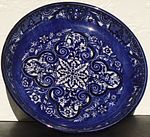- North Shields Pottery
-
North Shields Pottery was established at the Low Lights, North Shields in c.1814 possibly by Collingwood & Beall, although later, the business, trading as "William Collingwood & Company" was a partnership with John Thompson and although this was dissolved in February 1819, William Collingwood carried on alone.[1] Unfortunately, he was soon declared bankrupt[2]and by 1823 the business was owned by Nicholas Bird and trading as "Bird & Co.".[3]
In October 1826 the business was advertised for sale, under the name of "The Northumberland Earthenware Manufactory"[4] and a little later, Mr Bird was also declared bankrupt in October 1827.[5]In or around 1829, the business was owned by Messrs Cornfoot, Colville & Co. and by March 1832 "The North Shields Earthenware Manufactory" was doing business under the ownership of Cornfoot, Carr & Co.,advertising to the public for home consumption or exportation, their stock of best quality goods and ornamental vases of superior quality and exquisite workmanship.[6]
Following the demise of Mr.Cornfoot, in February 1838 the firm became known as "Carr and Patton" and were able,by their alliance with an eminent Staffordshire manufactory,to procure the newest models and patterns of any article of china of the best quality and fashion at manufacturers prices.[7] In July 1838, they provided the plates, etc. for a dinner given by the Borough of Tynemouth, for around 900 aged North Shields seamen, each piece having a portrait of the Queen in the centre surrounded by an inscription.[8] By 1846, Carr and Patton were listed as the owners of both North Shields Pottery and the Phoenix Pottery in Newcastle,[9] but this partnership was dissolved on 31st December 1846[10] and by 1850 the North Shields pottery was trading as "Carr & Co.". A few years later, in 1855, they announced the opening of a show room in Norfolk Street in the town, under the name of "John Carr & Son".[11]
Having produced brown and black wares in addition to the ordinary earthenware since the start, this was discontinued in 1856 and substituted with white, cream coloured, printed, painted and lustred (Sunderland Lustreware) varieties. These were also exported, principally to the Mediterranean ports and via Alexandria to Cairo and across the Red Sea to Bombay (Mumbai).[12]
In 1861, the name changed to "John Carr & Sons" and the firm remained as such until it closed.[13] In April 1884, a fire broke out in the drying house and the building was completely gutted, damage estimated to be under £1000.00.[14] However, in December 1893, a further fire broke out in the printing and dipping department and again the building was gutted and damage was considerable, very many pieces of ware in the final stages of preparation were lost.[15] The remaining stock of pottery was taken over by one of the employees, Mr.M.King, and sold from a large warehouse on the premises.[16]The manufacture of pottery had actually been discontinued since a change of ownership in June[17] and the end of pottery making in North Shields was confirmed with the sale of plant and machinery in March 1894, although the company did continue in the manufacture of glazed bricks and other similar items, until around 1910.[18]The firm eventually closed completely and the buildings were dismantled in 1913.[19]
During renovation work on nearby Cliffords Fort, whilst re-opening some embrasures which were bricked up during the 1880s, it was discovered that they had been filled with quantities of pottery waste from the Low Lights Pottery. As much of the production was for export, particularly to India and Egypt, many of the forms and patterns found were of a type not seen on Tyneside and it is hoped that enough material will be recovered to put together a small exhibition.[20]
The importance of the pottery to the local economy can be shown by the numbers employed. In 1851, this was 65 men, 32 women, 26 boys and 22 girls.[21] In 1861 this had become 50 men, 15 women and 20 boys.[22] Ten years later, this had changed to 54 men, 28 women, 38 boys and 22 girls,[23] and in 1881, adult employment had increased to 72 men, 45 women plus 21 boys[24]
References
- ^ London Gazette 9 February 1819
- ^ London Gazette 16 October 1819
- ^ Tyneside Pottery
- ^ Newcastle Courant 4 November 1826
- ^ Blackwoods Magazine Volume 22 July-December 1827
- ^ Northumberland Advertiser 13 March 1832
- ^ Newcastle Journal 24 February 1838
- ^ Newcastle Journal 7 July 1838
- ^ The Maritime Plan or Chart of the River Tyne
- ^ London Gazette 5th January 1847
- ^ Shields Daily News 27 December 1855
- ^ Maling and other Tyneside Potteries
- ^ Ward's Directory 1861, 1901.
- ^ Shields Daily News 4 April 1884
- ^ Shields Daily News 8 December 1893
- ^ Shields Daily News 24 March 1894
- ^ London Gazette 8 December 1893
- ^ Kelly's Directory 1910
- ^ Shields Daily News 2 October 1924
- ^ Tyne and Wear Conservation Team Annual Report 2002-03
- ^ National Census 1851
- ^ National Census 1861
- ^ National Census 1871
- ^ National Census 1881.
Bibliography
- Bell, R.C. (1971). Tyneside Pottery. Studio Vista. ISBN 0289700531.
- Bell, R.C.& Gill,M.A.V. (1973). The Potteries of Tyneside. Frank Graham. ISBN 0902833774.
- Bell, R.C. (1989). Maling & other Tyneside Potteries. Shire Publications Ltd. ISBN 0852637926.
- Jewitt, Llewellynn (1878). The Ceramic Art of Great Britain from Prehistoric Times down to the Present Day. Kessinger Publishing. ISBN 1104909758 (2009 reprint).
- Gibson,M. (2006). 19th Century Lustreware. Antique Collectors Club. ISBN 9781851493067.
- Blacker, J.F. (1911). Nineteenth Century English Ceramic Art. Stanley Paul Ltd. ISBN 9781151755780 (2010 reprint).
External Links
- List of Marks (John Carr) (The Potteries)
- Plaque Examples (Cornfoot Colville and Co.and John Carr) (Mate Sound the Pump)
- Tyneside Transfer Examples(United Collections)
Categories:- Ceramics manufacturers of the United Kingdom
- Ceramics manufacturers of England
- English pottery
- Pottery
Wikimedia Foundation. 2010.


